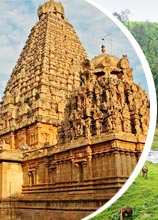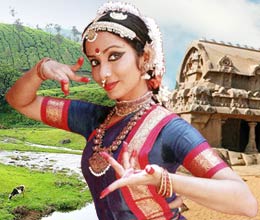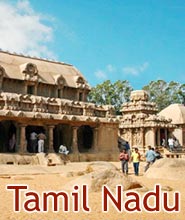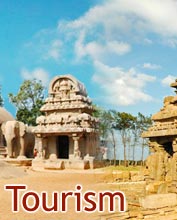 The
history of Tamil Nadu is very old and goes back to thousands of years
back. It is believed that the Dravidians of Tamil country were once a
part of the early Indus Valley settlers and moved south after the advent
of the Aryans around 1500 BC. However, the recorded history of human
civilization in Tamil Nadu goes back only to the 4th century BC. The
Sangam literature has several references to the social, economic and
cultural life of people in this part. The close proximity to the Sea put
the Tamil Country on the maritime map of the world even before the dawn
of Christian era. Over a period of time, the Tamils developed trade
links with ancient Egypt, Greece and Rome.
The
history of Tamil Nadu is very old and goes back to thousands of years
back. It is believed that the Dravidians of Tamil country were once a
part of the early Indus Valley settlers and moved south after the advent
of the Aryans around 1500 BC. However, the recorded history of human
civilization in Tamil Nadu goes back only to the 4th century BC. The
Sangam literature has several references to the social, economic and
cultural life of people in this part. The close proximity to the Sea put
the Tamil Country on the maritime map of the world even before the dawn
of Christian era. Over a period of time, the Tamils developed trade
links with ancient Egypt, Greece and Rome. Due to its geographical and strategic location, Tamilnadu remained a bone of contention for political supremacy among different empires. Prior to the Christian era, the Cholas, Cheras and Pandyas ruled the Tamil Country. The domains of these three dynasties changed many times over the centuries. Later, other dynasties like the Pallavas and the Chalukyas came into power. All these dynasties remained engaged in political skirmishes to retain supremacy over the land. The most remarkable aspect of these rulers was their patronage to literature, architecture, art and crafts. Most of these rulers gave their steady patronage to various arts that expedited the expansion of the Dravidian culture. The rich tradition of literature, music and dance, which were so ably supported by the Tamil rulers, continue to flourish to this day.
The early Cholas between 1st and 4th centuries ruled Tamil Nadu. The Cholas ruled the present Thanjavur and Tiruchirapalli districts. At the peak of their glory, the Chola kings expanded their influence as far as Ceylon (Sri Lanka) in the south and hundreds of kilometers across the northern region. Almost all the Chola Kings were magnificent temple builders. Brahadeswarer's Temple in Tanjore is a classical example of the magnificent architecture of the Chola kingdom. During the later half of 4th century, the Pallavas came into prominence and dominated the south for another 400 years. They ruled a large portion of Tamil Nadu with Kanchipuram as their base. The Dravidian architecture reached its epitome during the Pallava rule.
The Cholas again rose as a notable power in 9th century under Rajaraja Chola and his son Rajendra Chola. The Chola Empire extended to the central Indian states like Orissa and parts of West Bengal. Rajendra Chola went beyond, occupying the islands of Andaman and Nicobar, Lakshadweep, Java, Sumatra, Malaya and the islands of Pegu with his fleet of ships. The Chola power declined in the last quarter of the thirteenth century and the Pandyas re emerged as a mighty power, in the early 14th century. But the emergence of Pallava was short lived as Alauddin Khilji subdued them in the beginning of the 14th century. The city of Madurai was plundered and completely destroyed. The invasion destroyed the Chola and Pandya dynasties and later led to the establishment of Bahmani Kingdom in the northern Deccan.
Tamil Nadu was also a witness to the struggle between the colonial powers in which the British came out victorious. The British fought with various European powers, driving the Dutch away and reducing the French dominions in India to Pondicherry. The British also fought four wars with Hyder Ali and later his son Tipu Sultan, which led to their eventual domination of India's south. The British consolidated south India into the Madras Presidency.
The Nationalist movement in Tamil Nadu started in the late eighteenth century. The anti-colonial feeling in Tamil Nadu started as early as 1806 at Vellore. After independence in 1947, the Madras Presidency became Madras State, comprising of present day Tamil Nadu, coastal Andhra Pradesh, Northern Kerala, and the southwest coast of Karnataka. The state was later divided on linguistic lines. In 1968 the state of Madras was renamed Tamil Nadu.










